I grew up on a big farm in Saskatchewan, Canada and each summer during my teenage years, I would leave the farm to go and stay with a friend of my fathers who was a well known mineral prospector. He taught me all about mineral prospecting during those summers together, and it's really what I've been doing ever since. There's no better place on earth than Saskatchewan for the work I do. I now run my own mineral exploration and oil production company here; we have worked extensively in South and Central America and Europe, but we tend to focus on Saskatchewan now because it has such a wide variety of minerals, including diamonds.
In pre-COVID times we would tend to escape the Saskatchewan winters to a silver mining property my company owns in Jalisco, Mexico. That is where myself and two other prospectors, Felipe Robles and Gabino Jaimes, found Sydney; she was from a litter of puppies that had been poisoned, and was the last surviving pup.
She was only around 10 weeks old when we found her, so we took care of her, fed her up and took her to the town of Puerto Vallarta to a vet clinic. The vet told us Sydney was actually in pretty good shape, and gave her the shots and papers she needed to cross the Canadian border. Nestled in a carry-on bag, Sydney then joined me on a direct flight to Calgary. That was 13 years ago and she's been with me ever since.
Discovering Sydney's detection skills
For many years Sydney was my sidekick. She's just an incredible dog. We would drive long distances together and if there was ever a big truck approaching, she would always come over and give me a bit of a push, just to make sure I was aware of it.
Sydney's always been a ball-crazy dog, too. From a very young age, she just loved chasing a ball. But it wasn't until she was six years old that something really remarkable happened. I was taking her for a midnight walk on Granville Island in Vancouver when she smelt the scent of a ball underground and just went after it. She spent 30 minutes digging a hole and retrieved that ball. It dawned on me then that if I could replace the scent of a ball with a sulfide scent, we could train her to be a prospector.
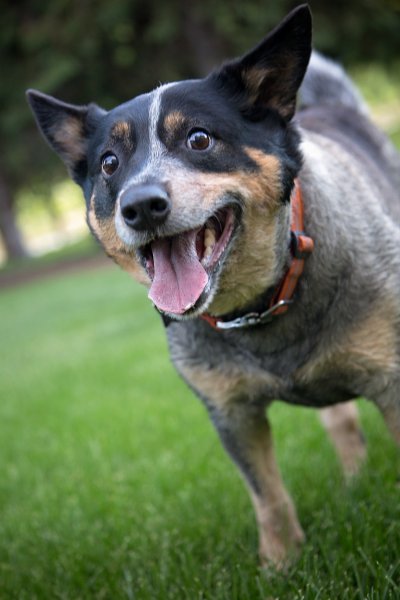


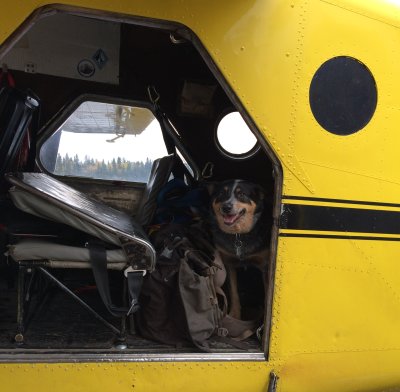
As a mineral prospecting company, we will typically visit a location after an aerial geophysical survey has taken place. A plane will have mapped the area and if that survey has shown some geophysical anomaly, something that could indicate a sulfidic mineral; say nickel, copper or gold, we will then hike through to investigate further. After I trained Sydney to detect sulfide scents, she would join us. If there is cover on the ground that obscures our view, she is able to detect any sulfidic minerals beneath. Provided it's a reasonable depth of course, she can't detect minerals buried 100 meters underground! Her method is to dig away at the ground, and then she'll make a little nest on what she finds and go to sleep on it. She's done her job at that stage and then she's so happy she just has a nap. But it's not like dogs hunting a scent across the countryside, it's quite a calm procedure.
The detection work Sydney is involved in is probably 20 percent of the whole work we do, but we didn't want to lose that. The mistake I made is thinking that any reasonably smart dog could do what Sydney does. I was wrong. It seems very few dogs can detect mineral sulfides and report back on them in the way she can.
We tried to see if Border Collies could do it, and they only could, but only to a degree. We then spent about six months with an Australian Cattledog called Jake but he still didn't have Sydney's capability. He did become Sydney's companion though, so he is now part of the family. Over the years we tried various other dogs but none had the capacity for detection that Sydney has.
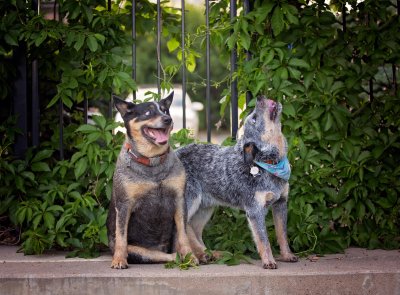

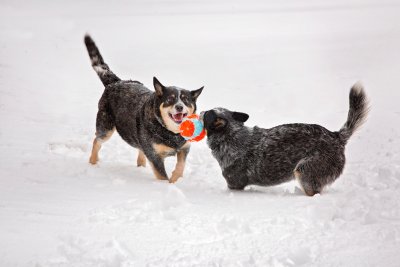

Sydney looks like an Australian Cattle Dog, but DNA tests showed that she is a mixture of more than seven breeds. We realized it would be impossible to breed another Sydney. Not least because Sydney went for more than half her life without us knowing she had this ability, so by that point she was spayed and couldn't have puppies.
Cloning Sydney in Texas
I began looking into cloning Sydney in 2018, but the only place I could initially find to do it was in South Korea. Then, in 2019, I discovered a place in Texas that clones pets, called ViaGen, and they were very easy to deal with. A local veterinarian completed a biopsy so we could provide tissue samples for the cloning process, those samples were sent to ViaGen for further processing and placed in storage until we pulled the trigger to clone Sydney in 2021.
I have no real understanding of the specifics of the cloning process, other than what I had to be involved in and provide in terms of tissue samples, but I have always been an advocate for animal welfare locally and in Mexico. Cloning Sydney cost us $50,000 and we thought that meant we were getting one puppy in the fall of 2021. Then, on July 9, I got a call saying, "Your puppies have arrived." I remember thinking, "Puppies? What are you talking about?" I believe that during the cloning process the embryo had split and two identical puppies were then born.
The cloned puppies arrive
But because of COVID we couldn't drive to the U.S. easily, so I took Sydney with me and chartered a plane from Winnipeg, Manitoba. We flew to Rochester, New York and a doctor from ViaGen brought the puppies to meet us at the airport. Quite honestly, to see those two puppies was a complete shock and I was pretty choked up. I almost didn't believe it had really happened until I saw them.
We let the little puppies, who we named Olivia and Fiona, out of their crate and they came over, wagging their tails and went to give Sydney a kiss. She gave a ferocious "guard dog" bark and we all scrambled, puppies included. But she loves the puppies now, and Fiona absolutely loves Sydney. Olivia not so much, but Fiona will snuggle against Sydney and lie on top of her.
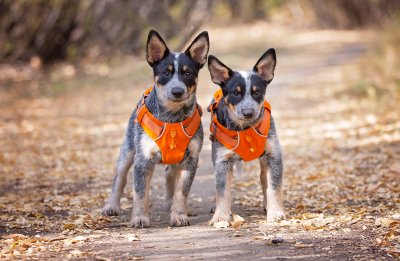


I can still remember the puppies' first meal in Canada: A rotisserie chicken shared in the back of a truck before we drove for seven hours across Canada's Northern Plains to get home. Back at my house, I woke up at 4am on their first night to see Olivia pulling Fiona across the living room floor on a blanket.
Sydney, Olivia and Fiona are three genetically identical dogs, so the slight strangeness of it does hit me at times. Sydney is imprinting her characteristics onto them, but each puppy has her own separate, distinct personality and they all have their little quirks. That's the most interesting aspect of all this for me.
The cloned puppies' personalities
Olivia is sweet and a little reserved, almost shy, while Fiona is boisterous and exuberant. But Olivia is the bigger dog. Fiona would have been considered the runt of a normal litter. When Fiona comes into the house she jumps on the couch and throws all the back cushions off. Meanwhile, Olivia wants to be on the bed the whole time. They have a game of Mexican stand-off that Fiona usually starts where she lowers her head and stares at Olivia from across the yard and then after 10 to 15 seconds they charge each other. About 99 percent of the time one of them chickens out at the last moment, and the chicken is usually the one that started the game.
Although they are different to her, they do have the same scrappiness that Syd has and like her, they love people and figure things out quickly. A typical one-mile walk takes over an hour because they stop and investigate everything. And just like Syd once did, they have spent their youth destroying several thousand dollars worth of furniture, coverings, wiring, reading glasses and sunglasses. Both are also completely ball crazy and very agile; they can almost catch a rabbit now at their current size, and that's saying a lot because our Saskatchewan rabbits are incredibly fast. I would say the puppies do have one big advantage over Syd though; they have her, Jake and each other to play with and to love as they grow up. Jake is the definitely glue that ties everything together. When we are out, he keeps an eye on where the puppies are, which is usually ahead of us, and runs back to keep an eye on Sydney.
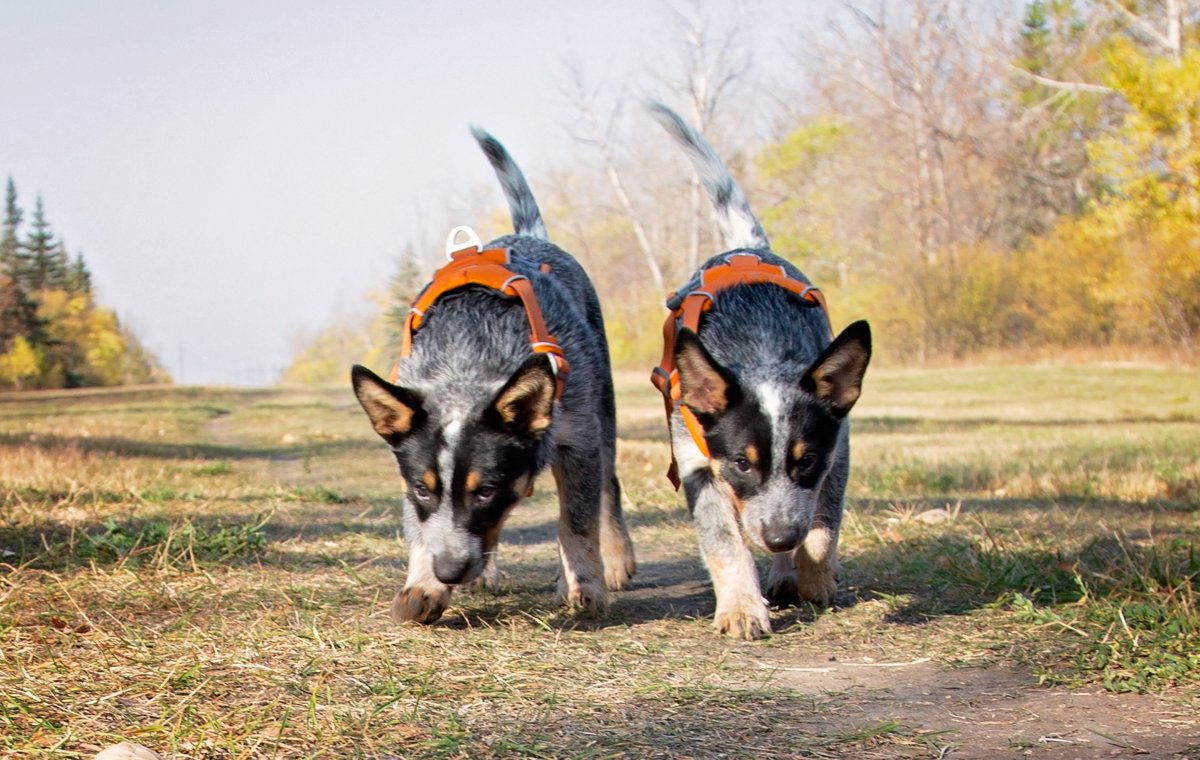
Having puppies is a full-time job for the first year, and it means always putting them first. Unlike Syd who was trained using a ball and leftover food containers of rocks, the puppies have a 900 square foot custom designed studio with six professionally made medical detection stands. It also has a nice leather couch.
I have found it takes around 400 training sessions, each around 15 minutes long, for a dog to develop confidence to hunt a particular scent, but our training is incredibly kind to the dogs and we see lack of praise as a punishment. Olivia and Fiona's official training is in its early stages, but both show incredible aptitude for one or two scents related to copper, nickel, gold and diamond. They really do have Sydney's instinct when it comes to scenting, but they go about it differently.
My first indication of the puppies' ability to detect scents happened with Fiona, I was leash training her with a harness when she was 100 days old. As we walked through the yard, she put on the brakes, started digging, and found a buried bone that was about three inches under the soil. She has been introduced to bones before, but she instinctively smelt this bone that had probably been buried there for more than a year.
People have different reactions to cloning, some think it's OK and others think it's wrong because there are so many dogs in shelters already. I can understand that perspective, but in our particular situation there really wasn't any other option than to reproduce Sydney in the way we did. I think people can be quite taken aback at first, but in my experience, they seem to change their minds on the ethics of cloning when they meet Olivia and Fiona. And, in my work circles, people know all about Sydney, so they are really enchanted by the puppies. Anyone familiar with Syd is excited that there are two more of her around to continue her legacy of mineral detection.
When we first brought the puppies in for a check up with our vet, she didn't know we had gone ahead with the cloning. I didn't tell her initially, I let her do the full assessment and everything was perfect in terms of their health. Then I said, "This is Sydney," and told her we had cloned Sydney. She couldn't believe it, she just stood there staring at the puppies. This vet has known Sydney for a long time.
Sydney, Olivia and Fiona's future
Sydney developed progressive retinal atrophy (PRA) in 2020 so she is unfortunately blind now, but she is in good spirits and good health and goes for a walk every day. Like most old dogs she like to be petted and brushed, sleeps late and loves her supper. We haven't done the testing to see if the puppies have the gene for PRA yet. There's that concern of course as they are identical dogs, but they are both in excellent health.
Last year Sydney came out in the field with us three times and now, we usually have to carry her for some part of any trail. I probably carried Sydney 3km to 5km on average each trip, and she's 50lbs, so it's a good workout. But she enjoys it and she wants to come. We don't push her to go and we always make sure we're in areas where there's lots of water so she can go for a swim and cool down. In the summertime we clip her so she doesn't overheat. In my work, our biggest concern is safety, for humans and more so for dogs. They depend and rely on us not to put them in hazardous situations. We take lots of precautions, but the main thing is that Sydney has a desire to go. If she didn't, she could stay somewhere really comfortable.


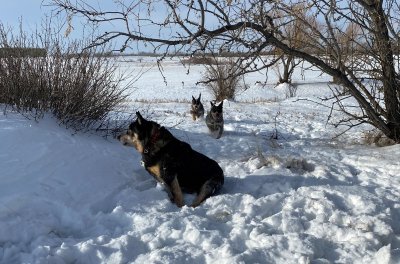
The puppies are around 220 days old now and their first official mineral prospecting trip will be in late May in Saskatchewan, but they have actually already been in the field once. I had a sitter arranged for them but it fell through so I took them with me on a trip. I couldn't leave them at the camp, so they came with me to Pete Lake and were part of the discovery team that found an old gold showing from the 1950s.
I'm not a dog breeder but eventually, when Olivia and Fiona are 5 or 6, if I could find good mates for them, it would be OK for them to have a pup or two each. That would be the cut off though, I already have four dogs and that is enough! I would clone a dog again if I was in the same situation, but fortunately we now have Sydney, Olivia and Fiona.
Shaun Spelliscy is the CEO of Gem Oil and owns Sydney, Jake, Olivia and Fiona.
All views expressed in this article are the author's own.
As told to Jenny Haward. Additional details from a text written by Shaun Spelliscy.
Uncommon Knowledge
Newsweek is committed to challenging conventional wisdom and finding connections in the search for common ground.
Newsweek is committed to challenging conventional wisdom and finding connections in the search for common ground.





